New Osteoarthritis Knee Brace Technology – An Alternative to Knee Surgery?
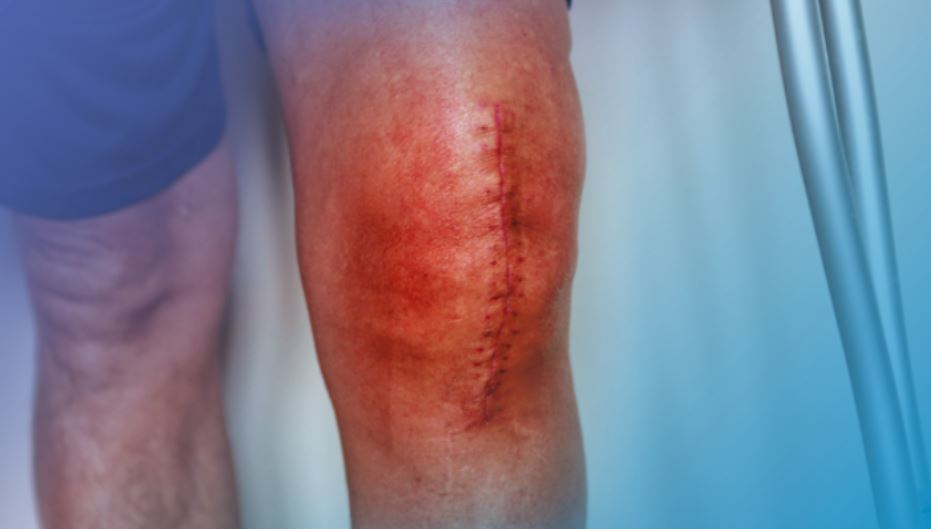
If your knee osteoarthritis has driven you to consider knee replacement surgery, keep reading. For many with moderate or severe knee osteoarthritis, surgery can seem inevitable. While knee replacement surgery is a well established and effective treatment option, reluctance to undergo the procedure is understandable. Knee replacements can be expensive and the recovery can be difficult. Fortunately, recent innovations in osteoarthritis knee brace technology may help you to reduce your consumption of painkillers and avoid or dramatically delay the need for surgery.
Tri-compartment Offloading Osteoarthritis Knee Braces
In the past, osteoarthritis knee braces were designed to help a small subset of patients whose arthritis is limited to just one side of their knee. Many patients with arthritis in other parts of their knee did not have an effective bracing option. Because of this, many had to consider other, often more invasive treatment options. Research indicates that only 3–20% of patients with knee osteoarthritis have it in the patellofemoral compartment or in multiple compartments1, 25. One study shows that less than 6%2 of those with knee osteoarthritis have it on just one side of their knee (medial/lateral tibiofemoral osteoarthritis).
Tri-compartment offloading technology is designed to treat all other patterns of knee arthritis. The 50–94%2-5 of patients with osteoarthritis in other parts of their knee now have a new non-surgical, non-drug option to manage their knee pain. If you experience pain that increases when using the stairs, squatting, bending, or any activity that requires a deep knee bend, it’s likely you are one of the 50–94%2-5.
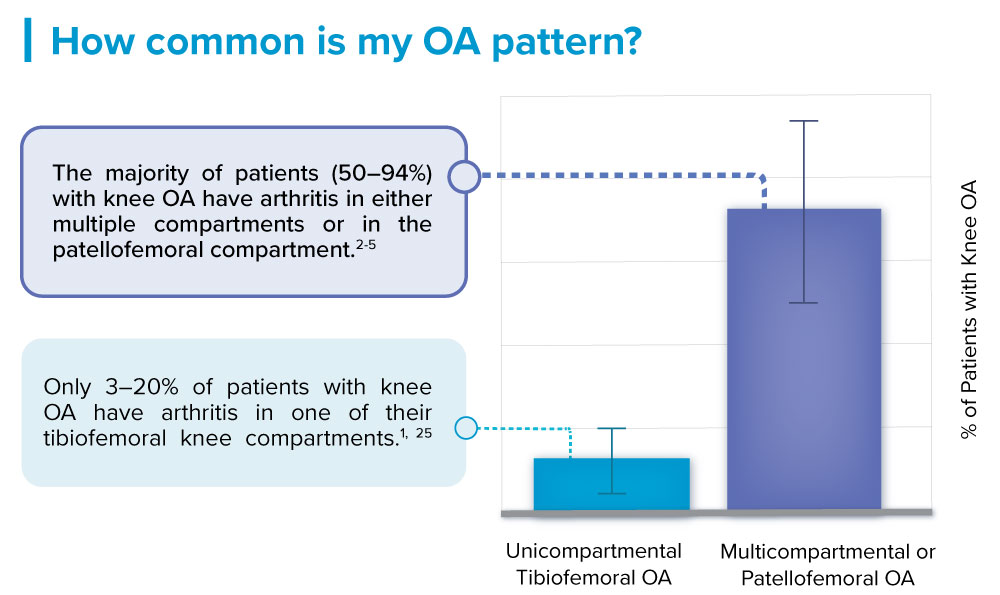
It turns out that there are actually seven different patterns of knee osteoarthritis. Some of these patterns are dramatically more common than others. Most people have what is called multi-compartment knee osteoarthritis2-5. This means that you have arthritis in at least two of the three compartments in the knee. What are compartments? These are areas of the knee joint where the bones place pressure on one another. In osteoarthritis, cartilage degeneration at these sites is the main cause of pain and disability. Learn more about osteoarthritis and knee compartments.
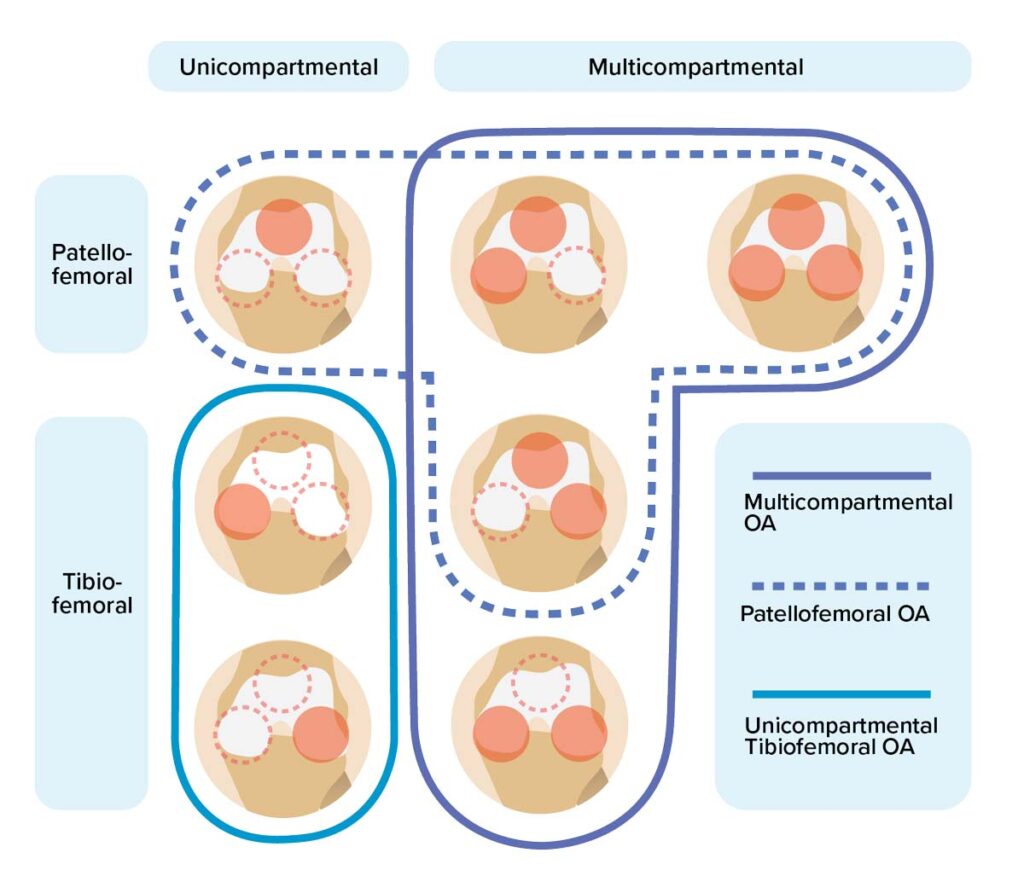
Tri-compartment offloading technology uses pneumatic liquid springs to distract (draw apart) and decompress your knee joint as it is bent. As a result, internal joint pressure decreases which can reduce pain and inflammation while increasing your joint strength and overall mobility. An osteoarthritis knee brace using tri-compartment offloading technology is designed to help over half 2-5 of all knee arthritis patients. This is a huge leap forward for knee bracing technology. For the first time, an osteoarthritis knee brace may help you avoid or significantly delay knee surgery.
The New Case for Osteoarthritis Knee Braces
Wearing an osteoarthritis knee brace with tri-compartment offloading technology is like instantly losing up to 45 lb of body-weight13. How big of a difference in knee pain and function does this make? Well don’t take our word for it – watch real people just like you react as they use a tri-compartment offloading osteoarthritis knee brace for the first time.
Whether you struggle with stairs, squatting, kneeling, lunging or really anything that involves bending your knee while bearing weight – tri-compartment offloading reduces pressure and pain.
Instant weight loss for the knee – let’s elaborate on this concept. Weight loss has long been touted as the gold standard non-surgical option for reducing knee osteoarthritis symptoms. Less body-weight means less joint pressure which reduces pain and wear. Scientists have studied the effect of weight-loss on osteoarthritis for decades; below are some of the highlights from they have found:
- A 1 lb decrease in body-weight provides a 4 lb decrease in internal knee loading and pressure.15
- Those who lose 5% of their body weight reduce their risk of osteoarthritis by 50%.15
- Patients who lost 10% of their body weight saw an average overall improvement in knee function of 28%.17
- To really feel any real benefit (clinically meaningful) in your knee function and pain while doing day to day activities, a 10-20% reduction in body weight is usually required. Further, Those losing the most (>20%) bodyweight typically see greater improvement in their symptoms.19,20,22,23
- For the average knee osteoarthritis patient, using a tri-compartment offloading knee brace can provide benefits comparable to a >20% loss in bodyweight.13
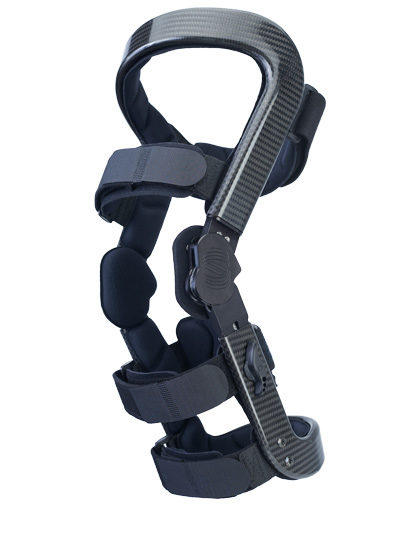
Scientists have found that during a 90-degree knee bend, tri-compartment offloader braces can reduce pressures within the knee to the same level that would be achieved by losing 45 lbs of body weight.13 For the average American male (age 60-69) weighing 195 lbs18, this is the equivalent of losing 23% of body weight. While a 10% reduction can make a huge positive change,17 a 20% reduction in body-weight yields even greater benefit19. If you are in pain exercise and weight-loss can be a challenge! The instant benefits provided by a tri-compartment offloader knee brace can help you increase your activity level while keeping your symptoms under control.
Knee Surgery vs. Osteoarthritis Knee Braces
Knee replacement surgery is becoming more popular and many are opting to undergo surgery at younger ages20. By 2030, it is expected that 1.3 million knee replacement surgeries will be performed annually in the United States21. While surgery is often effective, 20% of knee replacement patients remain unsatisfied with the final result of their procedure22. Furthermore, an estimated ⅓ of patients electing for surgery are not ideal candidates23. While surgery can be very effective for some, knee surgery is not always a silver bullet and comes with risks and limitations that you should be aware of.
How Long Do Knee Replacements Last?
Knee Replacement Surgery Recovery Timeline
Five Tips For Recovering From Knee Surgery
Those who respond well to knee surgery can realize life-changing benefits. One study of over 5000 people found that after two years, patients who underwent total knee replacement surgery improved their knee pain and function by 36%24. While this is significant, it is comparable to the benefits seen in those who have successfully dieted and lost 10% of their body-weight17.
Tri-compartment offloading osteoarthritis knee braces mimic the effect of dramatic weight loss and could be used to avoid and/or delay knee surgery. Experts recommend trying conservative treatment strategies (e.g. bracing, exercise, dieting, mobility aids) for at least six months before considering any invasive surgical procedures. Next time you are talking to your doctor about possible treatment options for your knee arthritis consider bringing along information regarding tri-compartment offloading osteoarthritis knee braces.
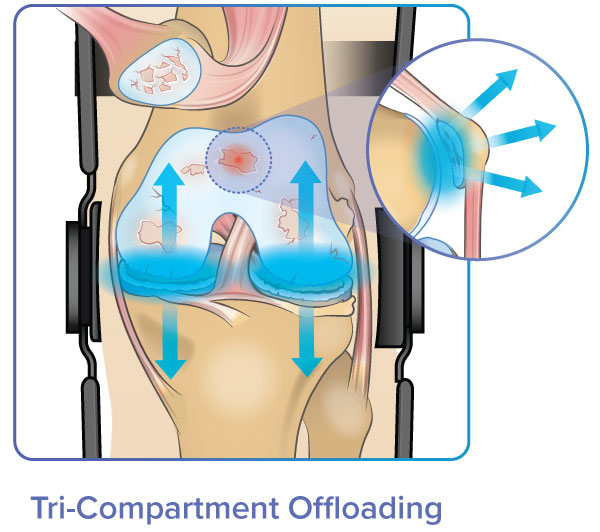
Managing My Knee Arthritis without Painkillers or Surgery
Choosing the Best Knee Arthritis Brace
Top Five Offloader Knee Braces
Or learn more about tri-compartment offloader braces here
References
- Heekin, R. D., & Fokin, A. A. (2014). Incidence of bicompartmental osteoarthritis in patients undergoing total and unicompartmental knee arthroplasty: is the time ripe for a less radical treatment?. The journal of knee surgery, 27(01), 077-082.
- Duncan, R. C., Hay, E. M., Saklatvala, J., & Croft, P. R. (2006). Prevalence of radiographic osteoarthritis—it all depends on your point of view. Rheumatology, 45(6), 757–760.doi:10.1093/rheumatology/kei270
- McAlindon, T., Zhang, Y,, Hannan, M., Naimark, A., Weissman, B., Castelli, W., & Felson, D. (1996). Are risk factors for patellofemoral and tibiofemoral knee osteoarthritis different?. J Rheumatol, 23(2), 332-337.
- Lankhorst, N.E., Damen, J., Oei, E.H, et al. (2017). Incidence, prevalence, natural course and prognosis of patellofemoral osteoarthritis: the Cohort Hip and Cohort Knee study. Osteoarthritis Cartilage, 25(5), 647-653. doi:10.1016/j.joca.2016.12.006
- Stefanik, J. J., Guermazi, A., Roemer, F.W., et al. (2016). Changes in patellofemoral and tibiofemoral joint cartilage damage and bone marrow lesions over 7 years: the Multicenter Osteoarthritis Study. Osteoarthritis Cartilage, 24(7), 1160-1166. doi:10.1016/j.joca.2016.01.981.
- Ledingham, J., Regan, M., Jones, A., & Doherty, M. (1993). Radiographic patterns and associations of osteoarthritis of the knee in patients referred to hospital. Annals of the rheumatic diseases, 52(7), 520-526.
- Baker, K. R., Xu, L., Zhang, Y., Nevitt, M., Niu, J., Aliabadi, P., … & Felson, D. (2004). Quadriceps weakness and its relationship to tibiofemoral and patellofemoral knee osteoarthritis in Chinese: the Beijing osteoarthritis study .Arthritis & Rheumatism: Official Journal of the American College of Rheumatology, 50(6), 1815-1821.
- Mohammed, K.S. Al-Obaedi, O. Shah, M. (2018). Prevalence of Compartmental Osteoarthritis of the Knee in an Adult Patient Population: A Retrospective Observational Study. EC Orthopaedics
- Duncan, R., Peat, G., Thomas, E., Hay, E. M., & Croft, P. (2011). Incidence, progression and sequence of development of radiographic knee osteoarthritis in a symptomatic population. Annals of the Rheumatic Diseases, 70(11), 1944–1948.doi:10.1136/ard.2011.151050
- McAlindon, T. E., Snow, S., Cooper, C., & Dieppe, P. A. (1992). Radiographic patterns of osteoarthritis of the knee joint in the community: the importance of the patellofemoral joint. Annals of the rheumatic diseases, 51(7), 844-849.
- Stefanik, J. J., Duncan, R., Felson, D. T., & Peat, G. (2017). Diagnostic Performance of Clinical Examination Measures and Pain Presentation to Identify Patellofemoral Joint Osteoarthritis. Arthritis Care & Research, 70(1), 157–161. doi:10.1002/acr.23238
- Spring Loaded Customer Survery. Manuscript Submitted for Peer Review (2018)
- Budarick BR, Bradley ME, Fitzgerald S, Cowper-Smith CD. (2019) Design and Mechanical Evaluation of a Novel Multi-Compartment Offloader Knee Brace. Manuscript Submitted for Peer Review.
- Messier SP, Mihalko SL, Legault C,Miller GD, Nicklas BJ, DeVita P, et al. Effects of intensive diet and exercise on knee joint loads, inflammation, and clinical outcomes among overweight and obese adults with knee osteoarthritis: the IDEA randomized clinical trial. JAMA2013;310:1263–73.
- Messier, S. P., Gutekunst, D. J., Davis, C., & DeVita, P. (2005). Weight loss reduces knee‐joint loads in overweight and obese older adults with knee osteoarthritis. Arthritis & Rheumatism, 52(7), 2026-2032.
- Felson, D. T., Zhang, Y., Anthony, J. M., Naimark, A., & Anderson, J. J. (1992). Weight loss reduces the risk for symptomatic knee osteoarthritis in women: the Framingham Study. Annals of internal medicine, 116(7), 535-539.
- Christensen, R., Astrup, A., & Bliddal, H. (2005). Weight loss: the treatment of choice for knee osteoarthritis? A randomized trial. Osteoarthritis and Cartilage, 13(1), 20-27.
- Fryar, C. D., Gu, Q., Ogden, C. L., & Flegal, K. M. (2016). Anthropometric reference data for children and adults; United States, 2011-2014.
- Messier, S. P., Resnik, A. E., Beavers, D. P., Mihalko, S. L., Miller, G. D., Nicklas, B. J., … & Guermazi, A. (2018). Intentional Weight Loss in Overweight and Obese Patients With Knee Osteoarthritis: Is More Better?. Arthritis care & research, 70(11), 1569-1575.
- Goudie, E. B., Robinson, C., Walmsley, P., & Brenkel, I. (2017). Changing trends in total knee replacement. European Journal of Orthopaedic Surgery & Traumatology, 27(4), 539-544.
- Koechlin, F., Lorenzoni, L., & Schreyer, P. (2010). Comparing price levels of hospital services across countries.
- Beswick, A. D., Wylde, V., Gooberman-Hill, R., Blom, A., & Dieppe, P. (2012). What proportion of patients report long-term pain after total hip or knee replacement for osteoarthritis? A systematic review of prospective studies in unselected patients. BMJ open, 2(1), e000435.
- Riddle, D. L., Jiranek, W. A., & Hayes, C. W. (2014). Use of a validated algorithm to judge the appropriateness of total knee arthroplasty in the United States: a multicenter longitudinal cohort study. Arthritis & rheumatology, 66(8), 2134-2143.
- MacDonald, S. J., Charron, K. D., Bourne, R. B., Naudie, D. D., McCalden, R. W., & Rorabeck, C. H. (2008). The John Insall Award: gender-specific total knee replacement: prospectively collected clinical outcomes. Clinical orthopaedics and related research, 466(11), 2612-2616
- Shahid, M. K., Al-Obaedi, O., & Shah, M. (2018). Prevalence of compartmental osteoarthritis of the knee in an adult patient opulation: A retrospective observational study. EC Orthopaedics, 9(10), 774–780.
A tri-compartment offloader is a knee brace that reduces force from across all areas of the knee joint.
Traditional offloaders are uni-compartment offloaders, and they redistribute force from one side of the knee joint to the other side. Tri-compartment offloaders use liquid springs to decompress the knee joint, which results in a significant reduction of pressure in the knee joint equivalent to losing 45 lbs of body weight.
Some patients are able to avoid or significantly postpone knee surgery with a tri-compartment offloader.